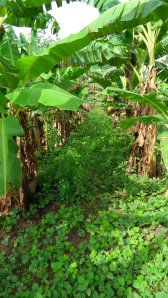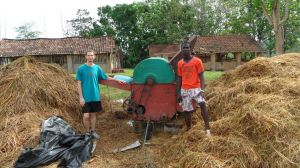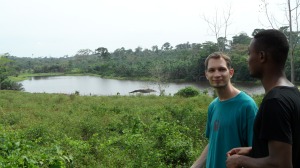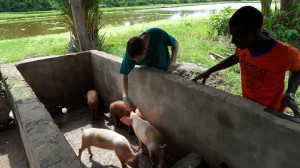
Staying in bed for five days straight, glucose infusion with quinin tied with shoe laces to a hat stand, and this boy pretending to be a doctor… I was glad when it was over.
Sorry for the great delay of the post. Reason was I got sick and had to undergo the Quinin treatment for Malaria. I had a doctor visiting me at home, so it was alright. The most annoying thing about it is having hallucinations from both the sickness and the medication; furthermore, the combination of feeling sick, anemia, insomnia and fever really drains you. But since people have Malaria many times around here, everyone was calm and everyone had extra advice on what to do 🙂
Africa is often associated with desert, famine and draught. While for some regions that is true, the west-African region from coast until the Sahel provides an immense potential with its arable land and stable climate. Many African countries try to skip the step of succeeding in agriculture in the race for becoming an emerging country. 400 million Africans live in extreme poverty, of which 70% live in rural areas dependent on agriculture. Yet, how much do governments invest into the sector? Only 8 of 54 countries of the African Union have kept their promise of the Maputo declaration of JUly 2003, to invest at least 10% of the annual budget into agriculture.
Remarkably, the multiplier effect of agricultural growth in sub-Saharan Africa is estimated to be 11 times greater in reducing poverty than in other non-agricultural sectors, such as utilities and mining.
– Dr Sipo Moyo, Africa Director of ONE (http://www.one.org/)
Just about an hour’s trip from Abidjan’s market and bus station Adjame is INPRAT (Institut PRive d’Agriculture Tropicale), a school for secondary and tertiary level education on agriculture. Since arriving in Cote d’Ivoire I’ve always wanted to see tropical vegetation and how agriculture works here, so I visited my friend Mafoya at INPRAT.
The change from city to countryside is immensely refreshing for all senses: no bad smells and exhaustion fumes, less rubbish on the streets, less people yelling and running about. All is replaced by a peaceful tranquility, balm for the mind of a stressed teacher 😉 The school grounds are in the forest, but students live in a village across the street.
I asked for a full tour, though I’ve forgotten to take pictures of the actually school buildings. But anyways, they are just buildings like in the city. At the school there are around 500 students from age 16 till 27, who all chose their preferred field of expertise in the sector: fish-farming, cow-herding, breeding rabbits; cultivation of plants such as maize, yam, cassava, rice or plantain; the extraction of rubber from Hevea plants – and all the theory that goes with it.
When we arrived on Saturday, we met the headmaster of the school, who made little effort to greet, but much more effort to advertise the agricultural sector: “Agriculture is good money! Welcome to our school.”
Here we are at a rice field. Ghana and Cote d’Ivoire used to be self-sustaining in their rice industries until the 90s, when government deemed the crop’s quality not good enough and changed to import, mainly from Vietnam. In a slow struggle, rice is making its way back, and you can find “Riz local” at the market.
Plantain is a type of banana that’s used for cooking. It’s tough and less sweet than the common banana that we find at the supermarket in Europe. Plantain is either cooked or fried, and usually served with fish. Aloko is one of the favourite national dishes.
As you can see the school actually plants the trees in rows… which is not the case when you go to the fields and plantations of the farmers of the village. Only the big food producers use land that systematically.
A football field… the cows are not supposed to be there, but they seem to enjoy their outing. The cattle is a rather small species, their shoulders barely reaching our hips. The main purpose is meat.
The machine for the rice-shredding. Yeah, it’s rather ancient. In the back you can see the stalls for rabbits and quail. Unfortunately all but one quail got eaten recently… by forest ants. Damn nature, you scary!
The beautiful lake which is providing the water for the fish-farming.
New piglets, just couple of months old. They reach maturity so fast!
Hevea Brasilensis, the rubber-tree is a new trend in west-Africa. After about 20 years of growth, the tree’s circumference is measured 1 metre above ground. If the circumference is beyond 50cm, the harvest of rubber can begin: with a very sharp machete, the farmer cuts the bark of the tree in an inclined way, so the sap flows down into a bowl. Having produced rubber in a chemistry laboratory, seeing rubber being extracted from trees seemed like magic to me.
A peaceful little hut in the forest 🙂 It turns out this is an illegal distillery run by the village. They distill palm wine here. Looks neither safe nor clean – and definitely illegal; therefore hidden in the bush.
Refreshing ourselves after the tour with some cold, bottled water. The water from the tub is also drinkable, but tastes of soil. The fruit in the foreground is used to produce the orange-reddish palm oil, the most common oil for cooking in west-Africa.
These two students, friends of Mafoya, repeatedly asked me to search for Austrian wives for them, and vehemently proclaimed their being serious about it. So, any takers? 😉
The president of the student’s union was working hard cutting some bamboo for building. He did not fail to tell me about how agriculture is the best, and how it makes a lot of money.
A cocoa tree in the middle of the village. When the fruit becomes orange like the one in the center of the picture, you can harvest the crop. The inside is eatable, but the main product is the seed, which is dried and exported to Europe for processing. Cote d’Ivoire is the world’s #1 cocoa exporter.
Finally, a nice meal before going back to Abidjan: Soy beans, tomatoes, white pepper, onions and garlic, with palm oil and rice. All ingredients from the village market, all natural and pesticide free. It tasted amazing as well.
Agriculture surely is a sector to be watched closely in the following decades, concerning the constant fear of overpopulation and undernourishment. It is essential, though, that African leaders don’t sell out their farmers and arable land, else they will end up producing cheaply, and importing the products of their own produce all over again.


























